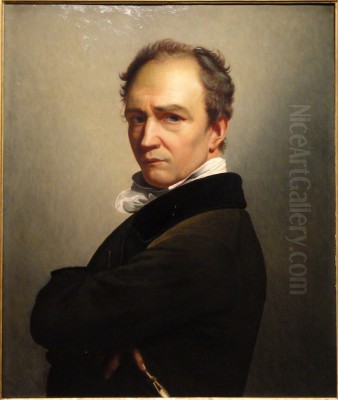
François-Joseph Navez (1787-1869) stands as a monumental figure in the annals of Belgian art history. A distinguished painter and influential educator, Navez was a pivotal proponent of Neoclassicism in Belgium, a style he masterfully adapted and propagated throughout his long and productive career. Born in Charleroi and passing away in Brussels, his life and work bridged the tumultuous late 18th century, the Napoleonic era, the birth of an independent Belgium, and the burgeoning artistic shifts of the mid-19th century. His legacy is not only etched in his own impressive oeuvre of portraits, historical scenes, and religious compositions but also in the generations of artists he nurtured as the esteemed director of the Royal Academy of Fine Arts in Brussels.
Early Life and Artistic Awakening
François-Joseph Navez was born on November 16, 1787, in Charleroi, a town in what was then the Austrian Netherlands, later to become part of Belgium. His early artistic inclinations led him to Brussels, where he enrolled at the Academy of Fine Arts between 1803 and 1808. During this formative period, he would have been immersed in the academic traditions of the time, focusing on drawing from casts of classical sculptures and studying the works of Old Masters. The prevailing artistic winds were still heavily influenced by the late Baroque and early Neoclassical stirrings that were sweeping across Europe.
The Brussels Academy, like many European art institutions of its day, emphasized rigorous training in draughtsmanship and composition. It was here that Navez honed his foundational skills, developing the precision and clarity that would become hallmarks of his later work. The curriculum would have exposed him to the principles of anatomical accuracy, perspective, and the hierarchical importance of subject matter, with historical and religious painting considered the noblest genres. This early training laid the groundwork for his future development, instilling in him a respect for classical ideals and technical proficiency.
The Parisian Crucible: Under the Aegis of Jacques-Louis David
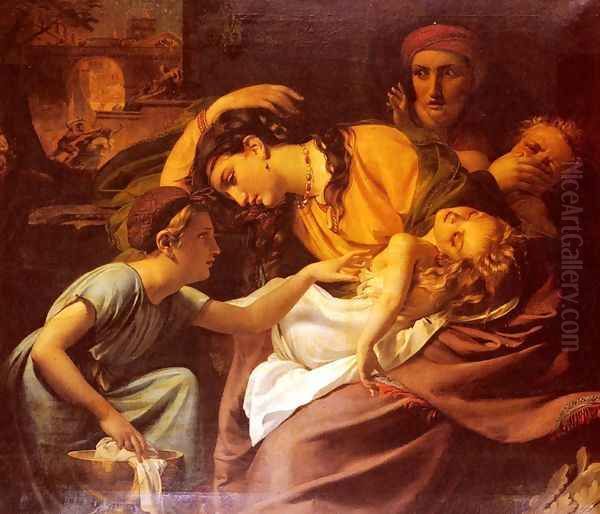
A significant turning point in Navez's artistic journey came in 1813. Having demonstrated considerable talent, he was awarded a scholarship by the Société des Beaux-Arts in Ghent. This prestigious award enabled him to travel to Paris, the undisputed epicenter of European art at the time, to further his studies. In Paris, Navez had the extraordinary opportunity to enter the studio of Jacques-Louis David, the leading figure of French Neoclassicism and court painter to Napoleon Bonaparte.
David's studio was a crucible of artistic innovation and rigorous discipline. His teachings emphasized the moral and civic virtues embodied in classical antiquity, advocating for a style characterized by clear outlines, sculptural forms, sober colors, and heroic subject matter drawn from Greek and Roman history, as well as contemporary events imbued with classical gravitas. Works like David's Oath of the Horatii (1784) and The Death of Marat (1793) had redefined history painting and set the standard for Neoclassical art.
Under David's tutelage, Navez absorbed these principles, refining his technique and deepening his understanding of Neoclassical aesthetics. He would have worked alongside other aspiring artists, some of whom would also achieve prominence, such as Jean-Auguste-Dominique Ingres and Antoine-Jean Gros, though Ingres, while a student of David, developed a distinct, more linear and sensuous style. The experience in David's studio was transformative, solidifying Navez's commitment to Neoclassicism and equipping him with the artistic vocabulary that would define his career. He remained in Paris, learning from the master, until 1817.
The Italian Sojourn: Encountering the Renaissance Masters
Following his formative years in Paris, Navez embarked on another crucial phase of his artistic development: a journey to Italy. In 1817, he left Paris for Rome, the spiritual home of classical art and a vital destination for any aspiring Neoclassical painter. He would reside in Italy, primarily in Rome, for approximately four years, until 1821 or 1822. This period was one of intense study and absorption, as he immersed himself in the masterpieces of antiquity and the Italian Renaissance.
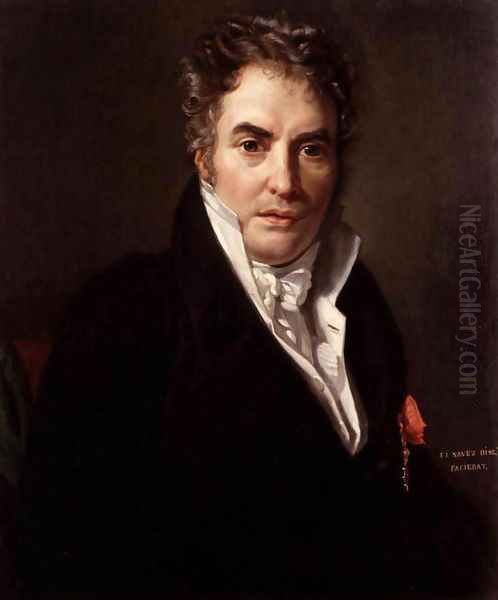
In Rome, Navez encountered firsthand the works of artists like Raphael, Michelangelo, and the Carracci brothers. The influence of Raphael, in particular, seems to have resonated deeply with him. While David's Neoclassicism often emphasized stark linearity and dramatic, sometimes severe, compositions, the Italian masters, especially those of the High Renaissance, offered a model of harmonious composition, graceful figures, and a richer, more nuanced use of color. Navez's exposure to these works subtly tempered the stricter Davidian style he had imbibed. He began to integrate a greater warmth, a more sophisticated palette, and a softer modeling of forms into his art, moving towards a Neoclassicism that was less austere and more sensuous.
During his time in Italy, Navez was not solely focused on grand historical or religious themes. He also produced numerous landscape studies, capturing the Italian countryside with a keen eye for light and atmosphere. This practice, common among artists visiting Italy, enriched his understanding of natural forms and color, which would indirectly benefit his figure compositions. His Italian experience was crucial in shaping his mature style, allowing him to synthesize the rigor of French Neoclassicism with the grace and chromatic richness of the Italian tradition. He also formed connections with other artists in Rome, including fellow painters Victor Schnetz and Léopold Robert, with whom he would later collaborate.
Return to Brussels and Ascendancy in the Belgian Art World
Upon his return to Brussels around 1822, François-Joseph Navez was a fully formed artist, equipped with a sophisticated technique and a clear artistic vision. He quickly established himself as a leading figure in the Belgian art scene. His style, a refined Neoclassicism enriched by his Italian experiences, found favor among patrons and critics alike. He became particularly renowned for his portraiture, a genre in which he excelled throughout his career.
His portraits were celebrated for their psychological acuity, elegant execution, and faithful likenesses. He painted prominent members of Belgian society, capturing their status and personality with a blend of Neoclassical dignity and a subtle, individualized realism. Beyond portraiture, Navez continued to engage with historical, mythological, and religious subjects, bringing to them the compositional clarity and noble sentiment characteristic of his school.
A notable development shortly after his return was his collaboration with Victor Schnetz and Léopold Robert, with whom he had associated in Rome. Together, they are credited with introducing and popularizing Italianate genre scenes in Brussels. These works, often depicting picturesque scenes of Italian peasant life, combined Neoclassical figure treatment with a romantic sensibility for the exotic and the everyday, appealing to a public eager for new artistic expressions. This venture demonstrated Navez's versatility and his engagement with contemporary artistic trends, even as he remained fundamentally a Neoclassicist.
Artistic Style: Neoclassical Ideals and Personal Inflections
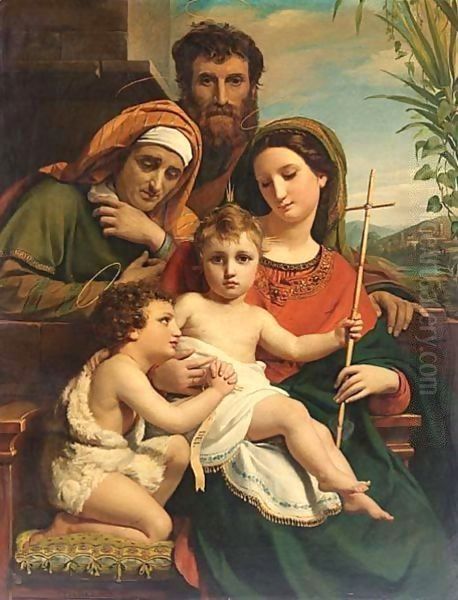
Navez's artistic style is firmly rooted in Neoclassicism, yet it bears his distinct personal inflections, shaped by his diverse training and influences. The core tenets of Neoclassicism – clarity of form, emphasis on line, balanced composition, idealized figures, and subject matter drawn from classical history, mythology, or morally uplifting religious narratives – are all present in his work. His figures often possess a sculptural quality, reminiscent of classical statuary, and his compositions are carefully structured to convey narrative legibility and emotional gravity.
However, Navez's Neoclassicism was not a slavish imitation of his master, Jacques-Louis David. The years spent in Italy, particularly his admiration for Raphael, imbued his work with a greater sensitivity to color and a softer, more harmonious modeling of forms. While David's later works could be characterized by a certain severity and a stark, almost theatrical lighting, Navez often favored a more nuanced palette and a gentler play of light and shadow. This resulted in a style that, while retaining Neoclassical rigor, often possessed a greater warmth and accessibility.
His portraits, for example, combine Neoclassical ideals of dignity and composure with a keen observation of individual character. He rendered textures with meticulous care and captured the sitter's personality without sacrificing an overall sense of classical balance. In his historical and religious paintings, such as The Resurrection of the Son of the Widow of Naïm (1857) and The Massacre of the Innocents, he demonstrated his ability to handle complex multi-figure compositions, imbuing them with dramatic power and emotional depth while adhering to the principles of clarity and order. His Portrait of Louis David is a testament to his skill and his connection to his influential teacher.
The Educator: Director of the Brussels Academy
Beyond his achievements as a painter, François-Joseph Navez made an indelible mark on Belgian art as an educator. In 1835 (some sources suggest as early as 1830), he was appointed Director of the Royal Academy of Fine Arts in Brussels, a position he held with distinction until 1862. This long tenure placed him at the helm of the country's most important art institution during a crucial period of national and cultural development, following Belgium's independence in 1830.
As Director, Navez was instrumental in shaping the curriculum and upholding academic standards. He instilled in his students the Neoclassical principles he espoused: rigorous draughtsmanship, a thorough understanding of anatomy and perspective, and a deep appreciation for classical art. His teaching methods were demanding, emphasizing discipline and a mastery of fundamental skills. He aimed to produce artists who were not only technically proficient but also capable of creating art that was morally edifying and intellectually engaging.
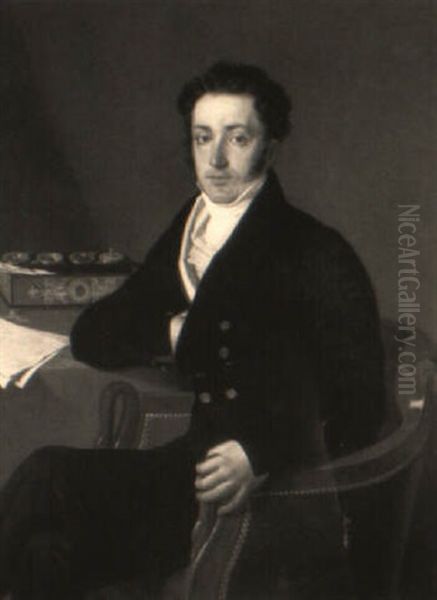
The Academy under Navez's leadership became a vital training ground for a new generation of Belgian artists. He fostered an environment that, while rooted in Neoclassical tradition, also saw the emergence of new talents who would go on to explore different artistic paths. His influence extended beyond the classroom; as a respected figure in the Belgian art world, his opinions and artistic choices carried considerable weight, helping to sustain the prestige of Neoclassicism in Belgium even as Romanticism and Realism began to gain traction elsewhere in Europe. He also held other significant positions, serving as Vice-President of the Royal Commission for Monuments and as a member of the Museum Commission, further shaping the cultural landscape of the young nation.
Notable Students and Their Divergent Paths
The impact of Navez as an educator is evident in the careers of his many students, several of whom became prominent artists in their own right. While he trained them in the Neoclassical tradition, his pupils often went on to develop their own distinct styles, reflecting the evolving artistic currents of the 19th century.
Among his most celebrated students was Jean-François Portaels (1818-1895). Portaels, after absorbing Navez's teachings, traveled extensively, particularly in North Africa and the Middle East, becoming a leading figure of Belgian Orientalism. While his technique bore the hallmarks of his academic training, his subject matter and exotic palette represented a departure from strict Neoclassicism. Portaels himself became an influential teacher, succeeding Navez in some respects and founding his own "atelier libre" (free studio), which attracted many young artists, including Théo van Rysselberghe.
Alfred Stevens (1823-1906) was another distinguished pupil. Stevens initially worked in a style influenced by Navez but later moved to Paris, where he gained international fame for his elegant genre scenes depicting fashionable Parisian women. His work, characterized by exquisite technique and a focus on contemporary life, aligned more with Realism and the burgeoning Impressionist movement, though always retaining a high degree of academic finish.
Jean Carolus (born Jean-Charles Joseph Degrandsart, 1814-1897), also a student of Navez, specialized in historical genre scenes and costume pieces, often set in the 17th and 18th centuries. His meticulously detailed and richly colored paintings enjoyed considerable popularity. Other artists who benefited from Navez's instruction or were influenced by his academic leadership include Fanny Geefs-Corr (née Corr, 1807-1883), a talented painter known for her portraits and genre scenes, and Adèle Kindt (1804-1884), who produced historical paintings and portraits. These artists, while diverse in their ultimate artistic expressions, all carried a foundation laid by Navez's rigorous academic training.
Navez and His Contemporaries: A Belgian Neoclassical Bastion
François-Joseph Navez operated within a vibrant and evolving European art scene. In France, while Neoclassicism, championed by figures like Ingres (who, like Navez, was a pupil of David), continued to hold sway in academic circles, the Romantic movement, led by artists such as Théodore Géricault and Eugène Delacroix, was gaining momentum. Romanticism, with its emphasis on emotion, individualism, and dramatic subject matter, offered a powerful alternative to the cool rationalism of Neoclassicism.
In Belgium, Navez was a key figure in establishing and maintaining a strong Neoclassical tradition. He can be seen as a counterpart to figures like Joseph Paelinck (1781-1839), another Belgian Neoclassicist who also studied in David's studio and worked in Rome. Together, they helped to define the character of Belgian art in the early decades of the 19th century. However, Belgium was not immune to the Romantic impulse. Artists like Gustave Wappers (1803-1874), Nicaise de Keyser (1813-1887), and Hendrik Leys (1815-1869) became prominent exponents of Belgian Romanticism, often focusing on dramatic episodes from national history.
Navez's role as Director of the Brussels Academy placed him in a position of significant influence, allowing him to champion Neoclassical ideals against these rising tides. While his approach was undoubtedly academic and traditional, his version of Neoclassicism, softened by Italian influences and adaptable to portraiture and genre, proved resilient. His relationship with these Romantic contemporaries would have been one of artistic dialogue, and perhaps at times, gentle rivalry, as different artistic philosophies vied for prominence. The sculptor François Rude, a contemporary, also worked within a Neoclassical framework but often infused his work with Romantic dynamism, reflecting the complex interplay of styles during this period. Sophie Rude (née Frémiet), François Rude's wife, was also a painter in the Neoclassical tradition.
Later Years, Legacy, and Enduring Influence
François-Joseph Navez remained an active and respected figure in the Belgian art world throughout his life. He continued to paint and fulfill his academic and civic duties for many years. He was elected to the Royal Netherlands Academy of Arts and Sciences in 1841, though he resigned in 1851 for personal reasons. His directorship of the Brussels Academy concluded in 1862, after nearly three decades of influential leadership.
Navez passed away in Brussels on October 12, 1869, at the age of 81. By the time of his death, the artistic landscape of Europe had undergone significant transformations. Realism, championed by artists like Gustave Courbet, had challenged both Neoclassicism and Romanticism, and the seeds of Impressionism were beginning to sprout. Yet, Navez's contributions remained undeniable.
His legacy is multifaceted. As a painter, he produced a substantial body of work characterized by technical mastery, refined aesthetics, and psychological depth, particularly in his portraits. His religious and historical paintings contributed significantly to the Neoclassical repertoire in Belgium. His works are preserved in major collections, including the Royal Museums of Fine Arts of Belgium in Brussels, the Museum of Fine Arts in Ghent, and the National Museum of History and Art in Luxembourg, among others.
As an educator, Navez played a crucial role in shaping several generations of Belgian artists. He upheld the standards of academic training and ensured the continuity of classical principles in Belgian art education. While some of his students, like Alfred Stevens, moved towards more modern styles, the rigorous foundation they received under Navez was invaluable. His influence helped to establish a strong "Belgian School" characterized by technical proficiency and a serious approach to art-making, which would continue to evolve with later artists like Constantin Meunier and even provide a tradition against which figures like James Ensor would later react.
Conclusion: A Pillar of Belgian Art
François-Joseph Navez was more than just a painter; he was an institution builder and a cultural anchor for Belgium during a formative period in its history. His unwavering commitment to Neoclassical ideals, tempered by a sophisticated understanding of color and form gained from his Italian studies, resulted in an artistic output that was both noble and accessible. His portraits remain compelling documents of 19th-century Belgian society, while his larger compositions speak to the enduring power of classical themes.
His long and influential tenure as Director of the Brussels Academy of Fine Arts cemented his legacy, ensuring that the principles of rigorous training and artistic excellence were passed on to succeeding generations. While artistic styles inevitably evolved, the foundation Navez laid contributed to the strength and vitality of Belgian art throughout the 19th century and beyond. François-Joseph Navez rightly holds a distinguished place as a master painter, a dedicated educator, and a defining force in the history of Belgian Neoclassicism.